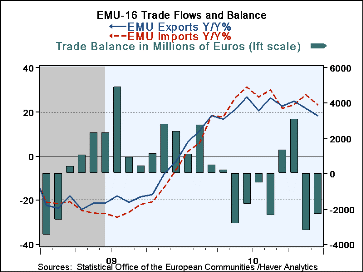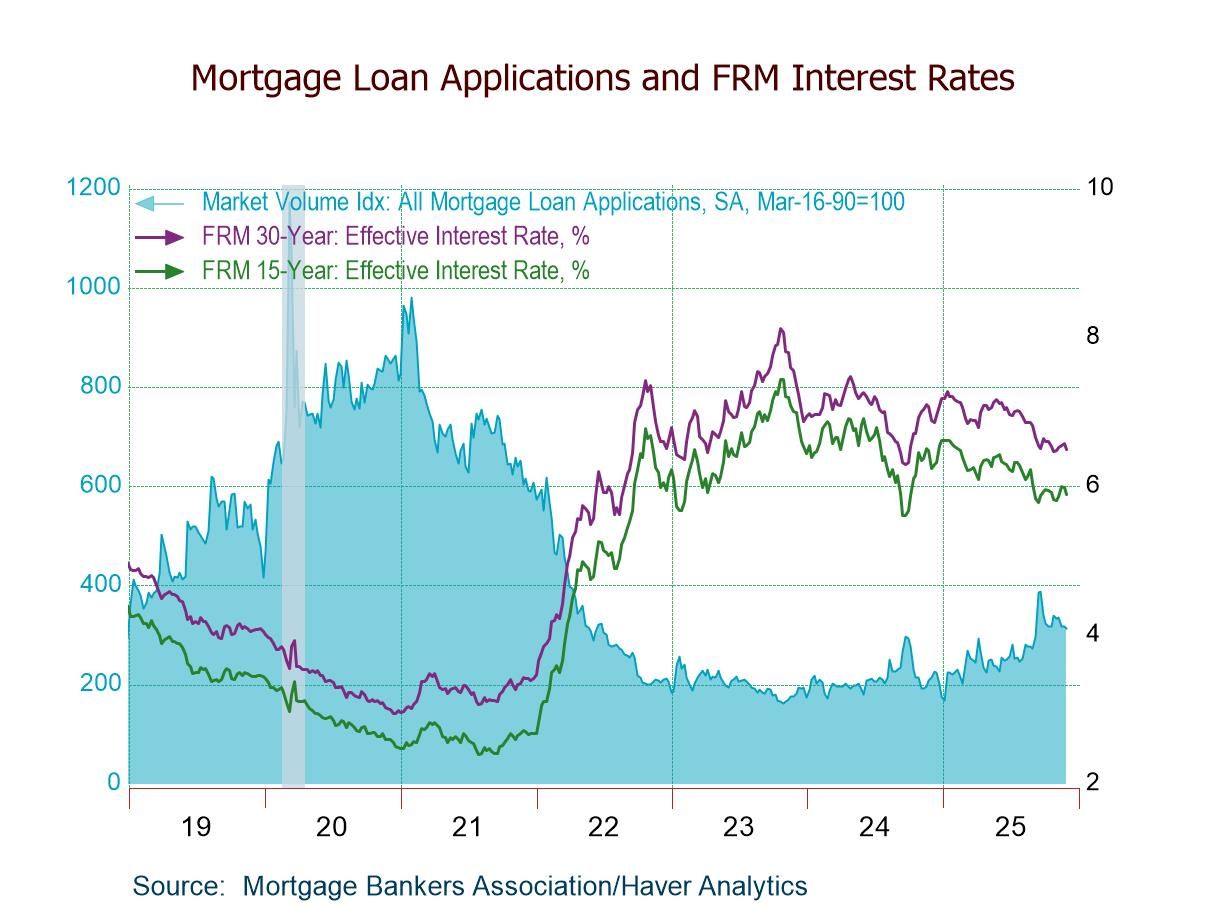 Global| Feb 17 2011
Global| Feb 17 2011EMU Trade Gap Stays Negative
Summary
In EMU exports are slipping faster than imports and that is keeping the trade deficit in negative numbers. This month Imports fell a bit faster than exports but not by enough to flip the deficit into positive territory. The sequential [...]
 In EMU exports are slipping faster than imports and that is keeping the trade deficit in negative numbers. This month
Imports fell a bit faster than exports but not by enough to flip the deficit into positive territory.
In EMU exports are slipping faster than imports and that is keeping the trade deficit in negative numbers. This month
Imports fell a bit faster than exports but not by enough to flip the deficit into positive territory.
The sequential growth rates tell the story, as export growth rates slip from 18% to 2% to 1.5% over horizons of 12-Mos to 6-Mos to 3-Mos, respectively. Exports are in a clear slowdown mode. Meanwhile, for imports the growth rates segueway from 23% to 3% to then pick up to 13% over spans of 12-mos to 6-Mos to 3-Mos respectively. Imports tell a less clear story.
In EMU exports of foods manufactures and other goods are slowing. Raw material exports are accelerating largely because of prices. Imports are declining for food and for manufactures, but the import decline for manufactured goods is less than the decline for exports. Imports of other goods are rising. Raw materials, of course, are accelerating because of prices.
On balance the export and import growth rates both are slowing down so we can’t use the trends to say that we more certain about growth. But imports are holding up better than exports and over three months the import growth rate had picked up; that is something. Meanwhile as of December EMU export growth rates were down to a 1.5% annual rate despite what has been strength from Germany.
| Euro-Area Trade trends for goods | ||||||
|---|---|---|---|---|---|---|
| M/M% | % SAAR | |||||
| Dec-10 | Nov-10 | 3M | 6M | 12M | 12M Ago | |
| Balance* | € (2,318) | € (3,234) | € 1,458 | € (664) | € 1,053 | € (4,026) |
| EXPORTS | ||||||
| All Exp | -0.4% | 0.0% | 1.5% | 1.9% | 18.4% | -2.6% |
| Food and Drinks | -2.6% | 2.8% | 2.9% | 5.1% | 15.9% | -1.6% |
| Raw materials | -3.8% | 2.2% | 17.5% | 11.3% | 24.2% | 20.6% |
| Other | -0.2% | -0.3% | 1.0% | 1.5% | 18.4% | -3.1% |
| MFG | -2.2% | 0.1% | -5.9% | -3.5% | 16.5% | -4.5% |
| IMPORTS | ||||||
| All IMP | -1.1% | 4.9% | 13.4% | 2.8% | 23.1% | -6.1% |
| Food and Drinks | -2.9% | 2.8% | -4.7% | 3.0% | 14.7% | -6.7% |
| Raw materials | -1.5% | 4.2% | 15.8% | -0.9% | 40.4% | -17.7% |
| Other | -1.0% | 5.0% | 14.6% | 3.0% | 22.8% | -5.5% |
| MFG | -3.5% | 2.5% | -3.8% | -6.0% | 18.3% | -6.4% |
| *Eur mlns; mo or period average (SA, WDA) | ||||||
Robert Brusca
AuthorMore in Author Profile »Robert A. Brusca is Chief Economist of Fact and Opinion Economics, a consulting firm he founded in Manhattan. He has been an economist on Wall Street for over 25 years. He has visited central banking and large institutional clients in over 30 countries in his career as an economist. Mr. Brusca was a Divisional Research Chief at the Federal Reserve Bank of NY (Chief of the International Financial markets Division), a Fed Watcher at Irving Trust and Chief Economist at Nikko Securities International. He is widely quoted and appears in various media. Mr. Brusca holds an MA and Ph.D. in economics from Michigan State University and a BA in Economics from the University of Michigan. His research pursues his strong interests in non aligned policy economics as well as international economics. FAO Economics’ research targets investors to assist them in making better investment decisions in stocks, bonds and in a variety of international assets. The company does not manage money and has no conflicts in giving economic advice.






